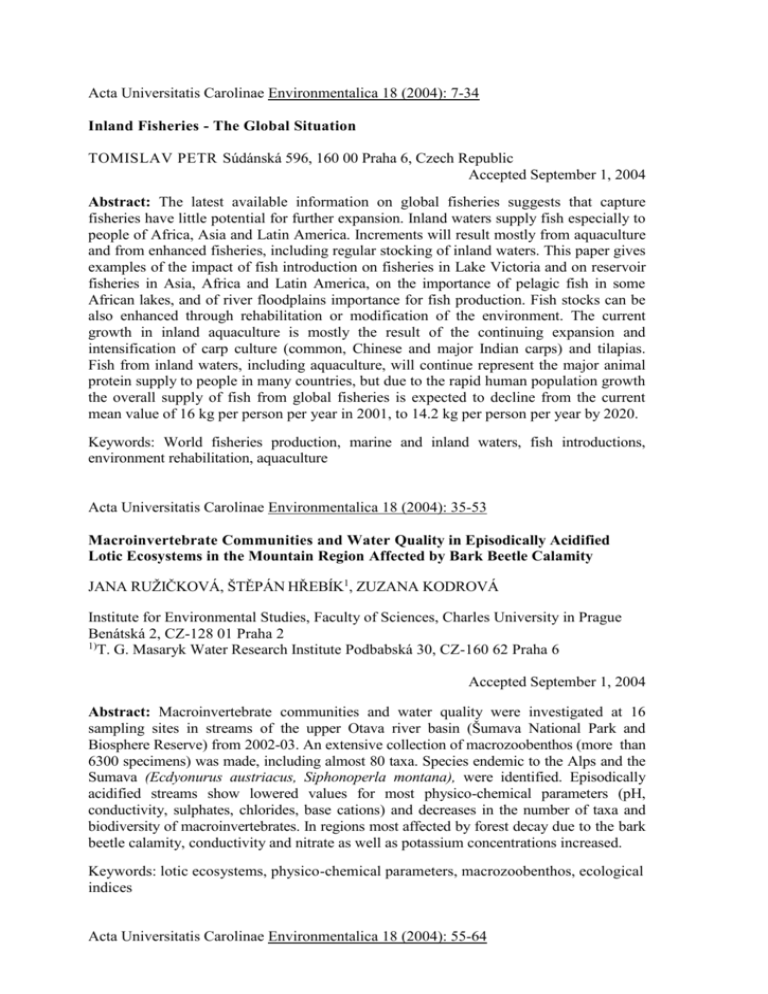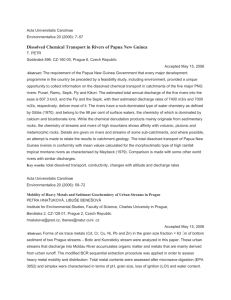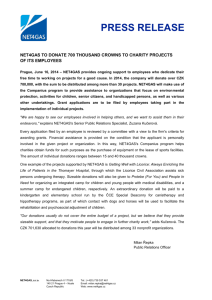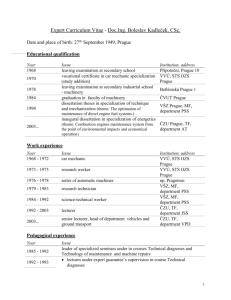Acta Universitatis Carolinae Environmentalica 18 (2004): 7-34
advertisement

Acta Universitatis Carolinae Environmentalica 18 (2004): 7-34 Inland Fisheries - The Global Situation TOMISLAV PETR Súdánská 596, 160 00 Praha 6, Czech Republic Accepted September 1, 2004 Abstract: The latest available information on global fisheries suggests that capture fisheries have little potential for further expansion. Inland waters supply fish especially to people of Africa, Asia and Latin America. Increments will result mostly from aquaculture and from enhanced fisheries, including regular stocking of inland waters. This paper gives examples of the impact of fish introduction on fisheries in Lake Victoria and on reservoir fisheries in Asia, Africa and Latin America, on the importance of pelagic fish in some African lakes, and of river floodplains importance for fish production. Fish stocks can be also enhanced through rehabilitation or modification of the environment. The current growth in inland aquaculture is mostly the result of the continuing expansion and intensification of carp culture (common, Chinese and major Indian carps) and tilapias. Fish from inland waters, including aquaculture, will continue represent the major animal protein supply to people in many countries, but due to the rapid human population growth the overall supply of fish from global fisheries is expected to decline from the current mean value of 16 kg per person per year in 2001, to 14.2 kg per person per year by 2020. Keywords: World fisheries production, marine and inland waters, fish introductions, environment rehabilitation, aquaculture Acta Universitatis Carolinae Environmentalica 18 (2004): 35-53 Macroinvertebrate Communities and Water Quality in Episodically Acidified Lotic Ecosystems in the Mountain Region Affected by Bark Beetle Calamity JANA RUŽIČKOVÁ, ŠTĚPÁN HŘEBÍK1, ZUZANA KODROVÁ Institute for Environmental Studies, Faculty of Sciences, Charles University in Prague Benátská 2, CZ-128 01 Praha 2 1) T. G. Masaryk Water Research Institute Podbabská 30, CZ-160 62 Praha 6 Accepted September 1, 2004 Abstract: Macroinvertebrate communities and water quality were investigated at 16 sampling sites in streams of the upper Otava river basin (Šumava National Park and Biosphere Reserve) from 2002-03. An extensive collection of macrozoobenthos (more than 6300 specimens) was made, including almost 80 taxa. Species endemic to the Alps and the Sumava (Ecdyonurus austriacus, Siphonoperla montana), were identified. Episodically acidified streams show lowered values for most physico-chemical parameters (pH, conductivity, sulphates, chlorides, base cations) and decreases in the number of taxa and biodiversity of macroinvertebrates. In regions most affected by forest decay due to the bark beetle calamity, conductivity and nitrate as well as potassium concentrations increased. Keywords: lotic ecosystems, physico-chemical parameters, macrozoobenthos, ecological indices Acta Universitatis Carolinae Environmentalica 18 (2004): 55-64 Aquatic Reclamations of Quarries after Mining of China Clay in the Karlovy Vary (Carlsbad) Region KATEŘINA ARONOVÁ, JAROSLAV TONIKA Institute for Environmental Studies, Faculty of Science, Charles University in Prague; Benátská 2, 128 44 Praha 2, Czech Republic Accepted September 1, 2004 Abstract: The paper presents information about water quality in artificial basins in the Karlovy Vary (Carlsbad) region. These basins are located in abandoned quarries after the surface or underground mining of china clay. Five different basins were studied, varying in age and origin. Mine water is the primary source for filling them; as a result of its chemistry there is only a few organisms in some basins. The main physical and chemical parameters of water quality were monitored: pH, conductivity, dissolved oxygen, BOD, COD, alkalinity, hardness (Ca+Mg), N-NH/, N-NO,-, total phosphorus, Fe, Mn, SO 42", Cl and transparency. The hydrobiological research was focused on qualitative and quantitative monitoring of phytoplankton, zooplankton and the concentration of chlorophyll a. According to most of the parameters the present water quality in the flooded quarries is similar to that of surface water. Keywords: residual mining pits, water quality, phyto and zooplankton Acta Universitatis Carolinae Environmentalica 18 (2004): 95-105 Organic Matters and Heavy Metals in Prague Streams and Ponds LIBUŠE BENEŠOVÁ, *DANA KOMÍNKOVÁ, MARTIN TONIKA PIVOKONSKÝ, JAROSLAV Charles University in Prague, Faculty of Science, Institute for Environmental Studies Prague, lbenes@natur.cuni.cz * Czech Technical University in Prague. Faculty of Civil Engineering, Laboratory of Ecological Risks in Urban Drainage Accepted September 1, 2004 Abstract: The main goal of this research was monitoring of organic pollution and concentration of heavy metals in Prague streams and ponds. There were selected 4 streams and 4 ponds in the whole Prague area, which were the most important. All streams and ponds are characterized by extended pollution from industry and farming. The recent sediments of streams are contaminated by heavy metals, with high concentration of Pb, Cu and Cd. Also they are affected by organic pollution as PBC. PAH and NES. It was proved the relation between concentration of NES and loss on ignition. Pond sediments have higher value of loss on ignition than stream sediments. The high concentration of heavy metals- Pb, Cu and Hg is really in Krčký pond (probably influence of waste water from hospital). Keywords: sediments, organic pollution, PBC, PAH, NES Acta Universitatis Carolinae Environmenialica 18 (2004): 83-93 Evaluation of the Impact (in Terms of Heavy Metals) of Highway Prague-Příbram (Central Bohemia) on Aquatic Ecosystems of Small Streams DANA KOMÍNKOVÁ 1), LIBUŠE BENEŠOVÁ 2) 1) Czech Technical University, Laboratory of Ecological Risks of Urban Drainage, Thákurova 7, Prague 6, 166 29, Czech Republic, phone +420 2 24355447, fax +420 2 24355445 kominkova@lermo.cz, 2) Charles University in Prague, Faculty of Science, Institute for Environmental Studies, Benátská 2, 128 01, Prague 2, Czech Republic Accepted September 1, 2004 Abstract: The aim of this research was to evaluate the impact of the highway PraguePříbram with respect to other anthropogenic activities in this region. The evaluation of the impact and the risk assessment was done using data obtained from the monitoring of three small streams in this area. Monitoring was conducted for a period of more than one year. The effect of the past mining activities and the highway was observed through the variation of the content of some heavy metals (Cd, Pb, Hg, Zn, Al, Fe, Mn and As) in water, sediment and suspended material. A culture enrichment factor, distribution coefficient and hazard quotient were used to evaluate all the data and assess the impact. The assessment of the ecological risk shows that for the sampling sites, which are affected, the levels of risk for the observed metals, expressed in toxicological units, occur in this order As>Pb>Cd>Mn>Zn. The ecological risk for the monitored elements on the reference sites occur in the following order Cd>Mn>Pb>Zn>As. The comparison with reference localities, where geological background is similar but the uranium deposit does not occur and the number of cars per day is significantly smaller, shows there are significant differences. Generally we can say that the hazard quotient for observed heavy metals on impacted sites are higher than on sites not influenced by the highway and mines. Distribution coefficients on polluted sites are generally slightly higher than on non-affected sites. Keywords: Heavy metal contamination; environmental risk assessment; hazard quotient; culture enrichment factor; distribution coefficient Acta Universitatis Carolinae Environmentalica 18 (2004): 65-81 Environmental Risk Assessment of Heavy Metals in the Kocába River DANA KOMINKOVÁ1), LIBUŠE BENEŠOVÁ2) 1) Czech Technical University in Prague, Laboratory of Ecological Risks in Urban Drainage, Thakurova 7, 166 29 Prague 6, Czech Republic, phone +420 2 24355447, fax +420 2 24355445 kominkova@lermo.cz, 2) Charles University in Prague, Faculty of Science, Institute for Environmental Studies, Benátská 2, 128 01, Prague 2, Czech Republic Accepted September 1, 2004 Abstract: Impacts of different anthropogenic activities were investigated in the Kocába River and its tributaries. The area of special interest of this study was affected by mining activities during previous centuries. Silver and lead were mined during the middle ages and uranium was mined recently. Mining was discontinued in the early 1990's. The samples of sediment, suspended solids, water and aquatic macroinvertebrates were analyzed for eight trace elements (Al, As, Cd, Hg, Fe, Mn, Pb and Zn). The obtained data were used for the risk assessment of these particular elements for aquatic organisms. Different types of criteria were used to assess the ecological risk; hazard quotient; a bioaccumulation factor and the distribution coefficient water- sediment. The results show that sediment is the main sink of heavy metals in the study area and when conditions change it can cause serious damage to the aquatic ecosystem, especially at the sites close to the mines. The risk assessment confirmed that past mining activity caused a long term impact on aquatic ecosystems quality. Keywords: heavy metals, risk assessment, biota sediment accumulation factor, distribution coefficient, hazard quotient Acta Universitalis Carolinae Environmentalica 18(2004): 107-116 Fish Assemblages in the Elbe River Watershed -Species Richness, Frequency, and Clusters KAREL PIVNIČKA AND MARTIN HUMPL Institute for Environmental Studies, Charles University in Prague, Faculty of Science, Benatska 2, 128 01 Praha 2, Czech Republic; e-mail: pivnicka@natur.cuni.cz Accepted September 1, 2004 Abstract: A logarithmic relationship S = a + b (ln km)2 was used for the assessment of the average number of species (S) on 1138 samples in relation to their distance from the source up to 250 km. The curve and its upper and lower 99 and 90% predictive limits are proposed as boundaries for verbal classifying of the amount of species in streams (high, good, fair, and poor), the upper 99% predictive limit as reference curve for the assessment of the values of species saturation index. The high value of the Salmo trutta m. fario brown trout frequency in upper parts of the streams is far above the expected linear semilogarithmic relationship between the species in rank order and their frequency. The most probable reason is the intense stocking of this species. Four clusters of species were identified in the longitudinal profile of streams. In the first cluster the only brown trout was found, further in the longitudinal profile with the Cotus gobio bullhead, Barbatula barbatula stone loach, and Thymallus thymallus grayling. In the second cluster, there are the Gobio gobio gudgeon, Rutilus rutilus roach, Perca fluviatilis perch, Leuciscus cephalus chub, and Leuciscus leuciscus dace, with the bullhead, stone loach. Lampelra planeri brook lamprey, and Phoxinus phoxinus minnow in upper parts of streams and with the Barbus barbus barbel, Albumus alburnus bleak, and Esox lucius pike in lower parts of the streams studied. This cluster verifies a continuity of fish assemblages in streams. In two remaining clusters, the stocked species the pike, Cyprinus carpio carp. Tinca tinea tench, Anguilla anguilla eel, and Aspius aspius asp prevail together with the Abramis brama bream, Abramis bjoerkna white bream, Carassius carassius crucian carp, Silurus glanis wels, and Gymnocephalus cernuus ruffe. Keywords: species saturation index, frequency of species, cluster analysis



